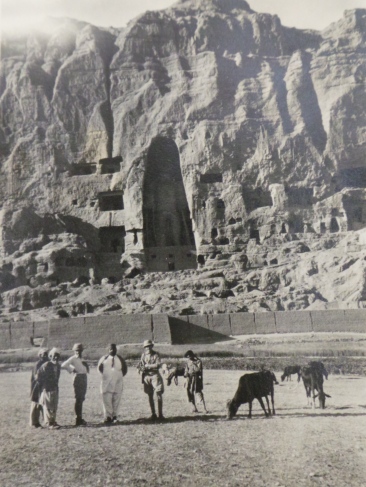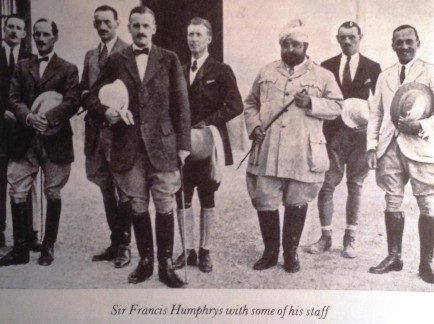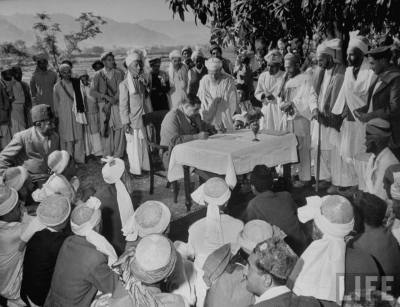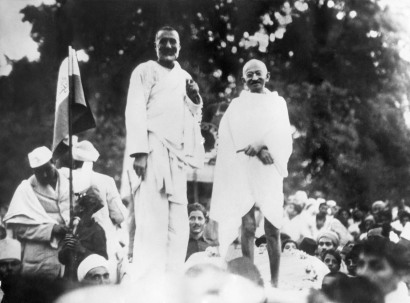I had a feeling I hadn’t finished with this photo. Three visitors to Bamiyan, with local guides, stand in front of the smaller of the giant Buddhas, in about 1926: the photo comes from the archives of the archaeologist and explorer Aurel Stein in the Bodleian Library, Oxford. A while back I wrote aboutidentifying the two figures wearing solar topees, Major Noel Williamson Amps on the right and Mary Amps, the latter of whom, I discovered, was in the process of becoming a dominant force in the world of Afghan-hound breeding.
Well, back in September I obviously got distracted by all the dogs. I certainly failed to do justice to Major Amps, and I failed even more abjectly to do justice to the impressive figure standing between Major and Mrs Amps, because at the time I had no idea who he was. I now know a bit more about Major Amps, and a lot more about the Amps’ companion on their trip to Bamiyan, Sheikh Mahbub Ali Khan.
In 1928 Noel Williamson Amps received a gong for coordinating the construction of the new British Legation in Kabul, a grand construction set in 23 acres to the N-W of the capital city. It was impressive even when I first saw it, in 2008, although by that stage it was a gutted ruin. For me it also had particular associations. A long time ago in Cyprus I met someone who had helped to catalogue the Legation library in the 1970s; more recently I was lucky enough to make the acquaintance of Jonathan Lee, a truly remarkable man who among many contributions to the preservation of Afghan history and culture had arranged for what remained of the library in 2001 to be transferred to the AREU, a Kabul research institute.
When it was built, in the 1920s, this splendid building fulfilled the Foreign Secretary’s requirement (at the time Lord Curzon, a man with a longstanding interest in Afghanistan and firm views regarding Britain’s proper place in the world) that Her Majesty’s representative in Afghanistan should be “the best-housed man in Asia.” There was more to it than that, of course. Exhausted by war, Britain’s influence on India’s strategic neighbour to the West was on the wane. After a short conflict in 1919, known as the Third Anglo-Afghan War, Britain had handed back to Afghanistan control of its own foreign policy: that moment is celebrated by Afghans as their Independence Day. Britain’s grand new complex just outside the city, constructed in the decade after those political developments, was clearly designed to assert Britain’s ongoing influence in Afghan affairs. Meanwhile the new king of Afghanistan, Amanullah, was doing his own bit of architectural self-assertion, marking his nation’s independence by building an extravagant new administrative district, Darulaman, to the S-W of Kabul, inspired by nation-building architectural programmes at Ankara in Turkey and at New Delhi.
An impression of the grandeur of the British building and grounds can be got from this film, from the fabulous collection on the website of the Centre of South Asian Studies at Cambridge University. But this footage in fact shows the Legation after it had come very close to destruction. On the foundation stone outside the front door was engraved Stet Fortuna Domus, “May this House Prosper,” but barely a year after its completion, in 1928/9, King Amanullah was overthrown by a revolt under the leadership of a man known as Bachaye Saqao (“Son of a Water-carrier”). The provocation for the rebellion was a series of reforms that might look innocuous to a Western liberal (for example, measures on education and female emancipation), but which were too radical for the deeply conservative population of Afghanistan outside Kabul. Amanullah’s implementation of his reforms was also far too precipitate. As the rebellion closed on Kabul, the British Legation and its population of men, women and children found themselves on the front line between government and rebel forces for an extended period, trapped and hit by “sixty-six shells and thousands of bullets”, according to the head of the Legation, Sir Francis Humphrys. Some impressive old-school sangfroid was on display: Lady Humphrys, Sir Francis’ wife, describes in her diary the difficulty of using the bathroom one day: “Dressing difficult today. Bath filled with water as a reserve because of pumping difficulties and wash basin in fire zone.” Sir Francis’ pipe, never seemingly extinguished, became key to the morale of the people in the Legation. The story of the successful evacuation to India of the British staff and other foreign missions around Kabul is compellingly told in Anne Baker’s Wings over Kabul, a great read if you can find it.
By this stage the Ampses had left Afghanistan, it seems. But Sheikh Mahbub Ali Khan was in the thick of it at the (effectively besieged) Legation. Mahbub Ali was Oriental Secretary in the British Legation, a Pashtun from Peshawar who had joined the (British) Indian Political Service, and to whose “most wonderful work and courage” was attributed much of the success of the evacuations. In this photograph of the Legation staff Mahbub Ali is third from right, and I think that it’s Major Amps on the far right.
Mahbub Ali comes to prominence again, in very different circumstances. It is about 20 years later, by which time he held the position of Political Agent of Malakand, the senior British official in a section of the tribal territories along the border between British India and Afghanistan. In an image that is now iconic, originating in a Life Magazine special issue on the establishment of Pakistan in 1947, Mahbub Ali is shown in an assembly orjirga collecting thumbprints as signatures from tribesmen in Swat, indicating their agreement to be governed by the new state of Pakistan.
Not long before, as India moved messily towards Partition, Mahbub Ali had been caught up in a vicious controversy. In 1946 the leader of the Indian National Congress, Jawaharlal Nehru, travelled to the N-W Frontier in the hopes of garnering support among the Pashtun population there for Congress and its ideal of an undivided India. Nehru was accompanied on his trip by Ghaffar Khan, a Pashtun campaigner against British rule whose supporters, the Khudai Khidmatgars, “Servants of God,” or Red Shirts, were allied with Congress and opposed to the Muslim League’s demand for a separate Muslim homeland in Pakistan. Here is Ghaffar Khan with Gandhi in Peshawar in 1938.
Nehru’s visit in 1946 was not a success. It became pretty plain very quickly as the party toured the tribal territories that support for an alliance with the predominantly Hindu Congress was not high. The visitors suspected that, behind the abuse and violence that they found directed at them more or less everywhere they went, were the British authorities, and in his autobiography, My Life and Struggle, Ghaffar Khan reserves his most withering criticism for Mahbub Ali in Malakand:
This Agent, Sheikh Mahboob Ali, was an extremely mean and unscrupulous individual. He had been responsible for great suffering and even spiritual agony among our people. He was the same Mahboob Ali who, when he was in Kabul in the service of the British Ambassador David Humphrey [sic], had made a name for himself for the part he played in overthrowing Amanullah Khan, and placing Bacha Sakka on his throne.
This is a pretty exaggerated claim, even if the job of Oriental Secretary at the Legation suggests its share of local intrigue. But Ghaffar Khan was very supportive of Amanullah’s reforms in Afghanistan, shared his passion for education and women’s emancipation, and felt his demise deeply. In his autobiography he goes on to blame Mahbub Ali for the rough reception that he and Nehru experienced in Malakand, and Mahbub Ali was in fact subsequently suspended and prosecuted (and in the event, I should add, acquitted) for his role in events.
Ghaffar Khan really doesn’t pull his punches when he talks about Mahbub Ali, but in the process he provides (in how distorted a form, I can’t be sure) the only further information about Mahbub Ali’s later life I could find. A deeply religious man, Ghaffar Khan uses Mahbub Ali as evidence of God’s unerring justice:
A man may forget God and become so full of pride and arrogance that he thinks he can get away with anything. But he should remember that the wrath of God may overtake him at any moment. Everyone knows that where Mahboob Ali’s house once stood, now asses bray. At the end of his life he met with so much disrespect and had to bear such terrible suffering that even the hardest of hearts would soften towards him. He had a wife and two daughters. One of his daughters was shot by his nephew, in his own house and before his very eyes. The other daughter also died. His wife ran away, with every penny he possessed. And today no one even remembers his name. He has left neither children nor a good reputation and he himself has already been called to account for his deeds before God, to whom belongs all reckoning.
Vindictive words indeed from a man known as the “Frontier Gandhi”, committed to non-violence and the disinterested service of mankind. His tolerance had limits, and he clearly detested everything that Mahbub Ali of the Indian Political Service stood for. But Ghaffar Khan helped to ensure, despite himself, that Mahbub Ali wasn’t entirely forgotten. I should say that in my own case my first tip as to the identity of Mahbub Ali came from Owen Humphrys, grandson of the pipe-smoking head of the British Legation and the equally indomitable Lady Humphrys, who came along to a talk I gave on Bamiyan last year.
We’re a long way from that sunny image of Bamiyan in 1926. For the British Legation in Kabul, the British Empire in India, Mahbub Ali, Ghaffar Khan, and indeed for Afghanistan and its neighbours in general, there were turbulent decades to follow that peaceful scene. In 2013, though, so a report in the Tribune tells us, the old Legation building, now the Embassy of Pakistan, has been fully renovated. Symbolically, perhaps, while Darulaman, the symbol of Afghanistan’s independence, remains in ruins, Pakistan’s representative in Afghanistan has his “vice-regal seat”, in the words of Hamid Karzai, the current President of Afghanistan. Pakistan inherited the building from the British. It also inherited the role of Afghanistan’s intrusive, overbearing neighbor.
Llewelyn Morgan
Llewelyn Morgan




No comments:
Post a Comment